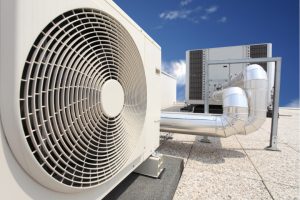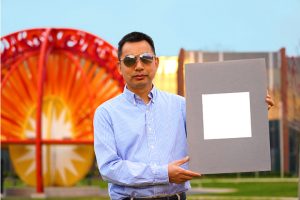Centuries before the laws of thermodynamics were described, no calculations were needed to know that buildings in hot, sunny regions had to be painted white to lower the interior temperature. Finally, in the 20th century, the invention of air conditioning brought the definitive solution to cooling buildings, or so it seemed until the climate change emergency reared its head. According to the International Energy Agency, air conditioning and ventilation equipment today account for 10% of global electricity consumption, and cooling technologies are responsible for 4%-10% of annual greenhouse gas (GHG) emissions, all of which the United Nations Environment Programme says “will be a disaster for the planet.” To reduce this demand, researchers are working on more sustainable systems, some of which hark back to the traditional concept of painting or covering buildings—an age-old idea, but with 21st century technologies.
The problem with air conditioning is not only that the production of the energy to power it likely emits GHGs, but also that, unlike passive solar heating, the law of thermodynamics means that cooling buildings to below ambient temperature generates heat that must be expelled outdoors, where it contributes to global warming. In other words, with air conditioning, the local air is the sink for the heat generated. In contrast, passive radiative cooling solutions (“passive” because they do not consume energy and “radiative” because they emit infrared radiation) are based on the idea that heat escapes from Earth without heating the air. While near-infrared radiation, with a wavelength close to that of visible light, is absorbed by air molecules, these barely interact with the mid-infrared, for which the freezing emptiness of space acts as a heat sink.
Covering materials for sustainable cooling
Radiative cooling is relatively easy to achieve at night, which is why researchers are currently developing solar panels that can generate electricity after the sun goes down. However, it is more complicated to do this in broad daylight, when sunlight heats up the materials—a goal that was considered unattainable until a few years ago. It was first achieved in 2014, when a team from Stanford University published the design of a covering material made of layers of silicon dioxide and hafnium dioxide that reflects 97% of sunlight and lowers the temperature to 5°C below the ambient air temperature, emitting mostly infrared radiation that is not retained in the atmosphere. The following year, researchers at the University of Technology in Sydney produced a combination of polymers with a thin film of silver that reflects almost 100% of the light in the full summer sun and remains 3°C below ambient and 11°C cooler than a nearby white-painted roof.
For Aurore Julien, an expert in environmental design at the University of East London, these investigations open a very promising path for sustainable cooling: “I believe that cool roofs, and more generally the careful considerations of emissivity of materials and finishes, can be a very important and effective way to support the passive cooling of buildings,” she tells OpenMind. “This type of consideration is becoming and will become a more normal part of building design.”

Subsequent research has tried to improve the technical qualities of these solutions. At the University of Colorado in 2017, a group of materials scientists created a translucent and flexible plastic sheet embedded with tiny glass spheres that reflect infrared radiation for better heat dissipation. The result is a material that reduces the temperature by up to 10 °C, close to the theoretical limit of daytime radiative cooling. Equally important is that these solutions are suitable for commercial use and at an affordable cost, which in this case would be achieved at a price of approximately half a dollar per square metre.
Work on these materials is therefore focused on achieving high performance standards at a reasonable cost, designing polymers that can be manufactured with common technologies such as moulding, extrusion and 3D printing, and using accessible and sustainable materials. For example, a team at Nanjing University in China has developed a film based on cellulose, the fundamental structural polymer of plants, that prevents ice from melting under sunlight.
Paints for roofs and facades
In addition to coverings, another field that is increasingly being explored is that of paints that can be applied directly to roofs and facades. This is the case of a proposal published in 2020 by researchers at Purdue University in Indiana. They have developed an acrylic paint with a calcium carbonate filler that reflects 95% of sunlight—normal white paints reflect around 80%—and lowers the temperature by almost two degrees. Although the performance of the paints falls short of that of polymer coatings, the great advantage, as the authors write in the journal Cell Reports Physical Science, is that this system offers “unprecedented benefits of the convenient paint form, low cost, and compatibility with commercial paint fabrication processes.”
Another team at the University of California, Los Angeles, has produced a white paint that reflects 98% of solar radiation. To achieve this, the researchers replaced the titanium oxide used in paints of this colour, which has the disadvantage of absorbing too much ultraviolet radiation, with other compounds such as baryte—barium sulphate, used by artists—or Teflon, the coating used in frying pans. According to the study’s lead author, Jyotirmoy Mandal, modifying the products we can buy in any shop is “within the capabilities of the paint and coatings industry.” Also using barium sulphate nanoparticles, the Purdue University team has come up with an improved formula—a Guinness World Record winner for the whitest paint—that reflects 98% of sunlight and can be applied in a thin enough layer for use on vehicles such as planes, trains and cars.
However, for a variety of reasons it may not always be desirable to paint surfaces white. In another study, scientists at Columbia University have designed a two-layer coating whose top layer can be adapted to absorb different wavelengths of visible light so that the desired colour is visible. This material generates a cooling effect of between 3 °C and 15 °C below that of conventional paint of the same colour. According to the authors, it is a “simple, inexpensive and scalable” solution.
Dynamic systems
All these approaches offer innovative and sustainable cooling solutions. However, for Julien, an impediment to their widespread implementation is that not all of them will be valid in every climate. “I do believe these technologies are extremely promising in hot climates,” she says. However, “they may not be suitable in the context of a very variable climate or a building where much heating is required during the winter season, as much insulation would be needed on the roof, reducing the impact of the cool roof,” she explains. And since the majority of the world’s population lives in temperate regions, it can be difficult to find the balance between the benefits of passive cooling and the demand for heating.

For such cases, Julien thinks that it may be necessary to combine these systems with others: “The dynamic systems such as for example those using a combination of evaporative cooling and radiative cooling by spraying water on the roof at night are more suitable for climates that also require lots of heating in the winter.” The expert notes that further development and experimentation will be required to determine the usefulness of these innovations and their optimisation for different climatic conditions.
At the end of the day, the biggest obstacle to radiative cooling becoming widespread is that it will have to face down a powerful competitor with a head start of more than a century. “The issue generally with the use of AC is that it is a simple, cheap and effective way to cool a building,” sums up Julien. “They are readily available and familiar systems, and building owners are confident that they can maintain or replace these systems.” Therefore, the expert suggests that a true transition towards more sustainable technologies may only occur when limitations are imposed on carbon emissions or the energy consumption of buildings. “If regulations are in place, this will help in developing new technologies,” she concludes.

Currently, repainting is already being tested as a way to cool buildings through pilot projects in places like New York and Ahmedabad in India, and some streets and pavements in Los Angeles have been painted white. Scientists at the Autonomous University of Barcelona have proposed a plan to combat the Catalan capital’s heat island effect by repainting rooftops white.
The results of these initiatives could help spread this measure around the world, providing solutions one brushstroke at a time. According to calculations by University of California professor and engineer Jeremy Munday, if 1%-2% of the Earth’s surface were painted with a product like the one developed at Purdue, global temperatures could be stabilised. Of course, this would require at least 526 billion litres of paint, spread over an area slightly larger than half the Sahara.
Comments on this publication